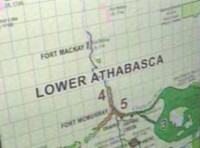Lower Athabasca Regional Plan will affect oil sands developments
 Albertans asked for input on first
Albertans asked for input on firstdraft Regional plan that supports conservation
and economic growth in regions at the center of future oil sands
developments.
Edmonton,
target=”_blank”>Lower Athabasca Regional Plan, which it
describes as a blueprint for vigorous economic growth, vibrant
communities and a healthy environment in northeast Alberta for
decades to come.
With oil sands production expected to double within the decade, the
draft regional plan will conserve more than two-million hectares of
habitat for native species. It will increase recreation and tourism
opportunities, plan for infrastructure and put strict environmental
limits in place for air, land disturbance and water.
Some existing oil sands leases could be revoked if the plan is
implemented as is. It is estimated that 14 energy
companies and 10 mineral companies will be affected by the
protected zones. However, conventional oil and gas companies will
not have their leases cancelled, officials said. But, their future
development will come under greater scrutiny.
target=”_blank”>Southern Pacific Resource Corp. was quick to
release a statement that the plan
on its development plans.
The plan considered input from an advisory council of
individuals with broad experience in the region, and input from the
public, municipalities, stakeholders and First Nation and Métis
communities. It is the first regional plan developed under
Alberta’s Land-use Framework.
“We are committed to the responsible development of the oil
sands and all our natural resources, and to managing the social and
environmental impacts,” said Sustainable Resource Development
Minister Mel Knight.
“With this plan, we’re looking ahead
more than a generation. It is government’s responsibility to plan
for the future and it is important that all Albertans have their
say.” Sustainable Resource Development Minister Mel
Knight
An target=”_blank”>online workbook is available for the next two
months and public input sessions begin April 18 in Bonnyville and
continue in 14 more locations through May 19.
The plan also includes regional science-based limits to protect
the air and water. Through regional planning, as well as other
initiatives, Alberta is moving towards managing the cumulative
effects of all development on the air, water and
landscape.
Management frameworks with science-based limits, and triggers to
signal where proactive efforts may be needed to avoid reaching
limits, will be in place to achieve the outcomes of the regional
plan.
Major additional areas of the Lower Athabasca’s land base are
identified as new conservation areas, bringing the total for
conservation and protected areas to more than two-million hectares
of legislatively protected lands in the region - a 20,000
square-kilometre area three times the size of Banff National
Park.
Ten new provincial recreation areas and six new public lands
areas have been identified, including Lakeland Country as an
important tourism destination. Government will work with First
Nations on an access management strategy for the Richardson
backcountry and to develop historic and cultural sites for tourism
in the region.
The draft plan also identifies strategic directions to improve
our ability to balance economic, environmental and social outcomes
in the region:
- Improving the integration of industrial activities on the
landscape; - More timely and progressive reclamation of disturbed
lands; - Managing air, water and biodiversity through management
frameworks that take proactive approaches and set limits and
triggers, and manage land disturbance in the region; - Designating new conservation areas that are interconnected and
support biodiversity; - Strengthening infrastructure planning to support future growth
of the region; - Designating new recreation and tourism areas to provide more
diverse recreation opportunities to local residents and tourism
products for visitors to the region; and - Inclusion of aboriginal peoples in land-use planning.
The draft regional plan emphasizes that private landowners make
decisions about how to manage their land consistent with existing
provincial and municipal legislation. The draft regional plan does
not change or alter property rights.
“No regional plan will be approved until legislation that
clarifies our respect for property rights is passed in the
Legislature,” said Knight.
Municipal governments maintain authority for local land-use
planning and development within their boundaries, but will have to
align planning and development decisions to achieve the outcomes
established in the regional plan within five years.
 The Government of
The Government of
Alberta also identified nearly two-million hectares of potential
conservation areas in the Lower Peace Region, connecting to
existing and proposed areas in the Lower Athabasca Region and Wood
Buffalo National Park.
The conservation areas in the two regions include part of the
range and habitat areas for six caribou herds and will advance
woodland caribou recovery efforts in Alberta.Work will begin on the
Lower Peace Regional Plan in 2012.
Located in the northeast corner of Alberta, the Lower Athabasca
Region covers about 93,260 square kilometres and contains most of
the province’s oil sands, large tracts of Boreal forest and the
communities of Fort McMurray, Bonnyville, Lac La Biche and others.
Released in 2008, the Land-use Framework sets out a new approach
for managing lands and natural resources.
The Alberta government is working to build a better Alberta by
fostering economic growth, strengthening our health and education
systems, investing in infrastructure, supporting safe and strong
communities and ensuring a clean and healthy environment.
target=”_blank”>The full plan is available here
Further information
target=”_blank”>Proposed Conservation and Recreation/Tourism Areas
in the Lower Athabasca Region(PDF)
target=”_blank”>Proposed Conservation and Recreation/Tourism Areas
in the Lower Athabasca and Lower Peace Regions (PDF)
You can return to the main Market News page, or press the Back button on your browser.

